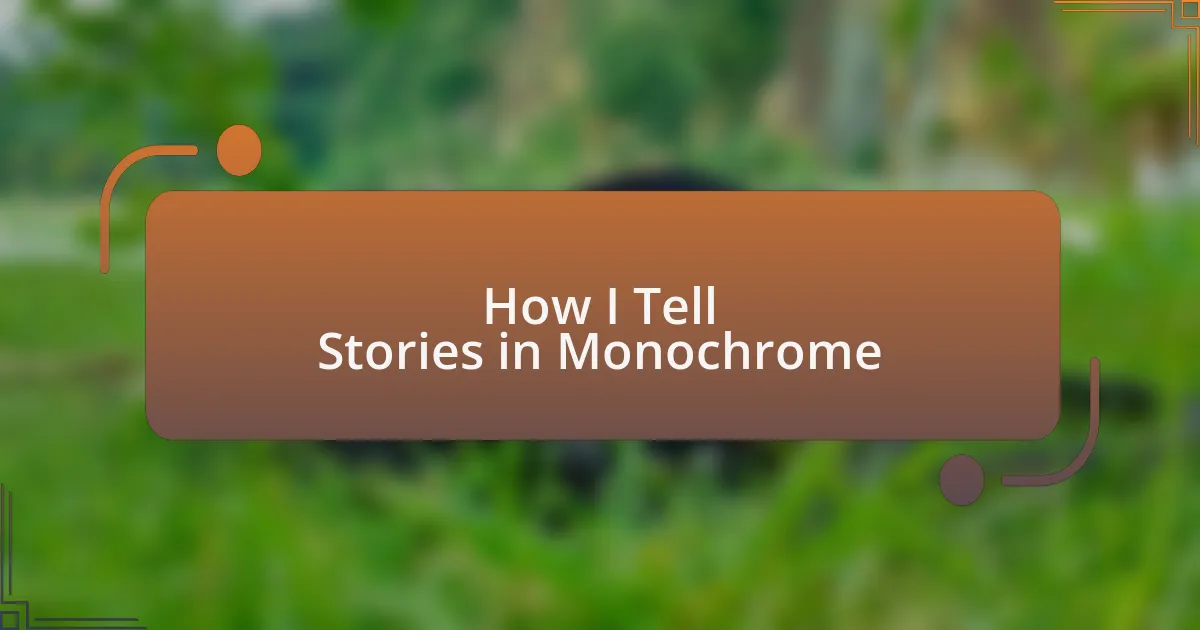Key takeaways:
- Monochrome photography reveals emotional layers by focusing on textures, contrasts, and storytelling without the distraction of color.
- Storytelling in photography connects viewers to deeper emotions and experiences, encouraging them to ponder the narratives behind the images.
- Techniques like adjusting contrast, emphasizing textures, and experimenting with composition can enhance the impact of monochrome images.
- Personal projects can illustrate themes such as urban solitude and shared human experiences through the interplay of light and shadow.
Author: Clara Ashton
Bio: Clara Ashton is a contemporary fiction author known for her evocative storytelling and richly drawn characters. With a degree in English Literature from the University of California, Berkeley, Clara combines her passion for writing with a deep understanding of narrative structure. Her debut novel, “Whispers of the Forgotten,” received critical acclaim for its poignant exploration of love and loss. Clara’s work has been featured in several literary journals, and she regularly contributes essays on the writing process. When she’s not crafting her next tale, Clara enjoys hiking in the Pacific Northwest and sipping artisanal coffee in local cafes. She currently resides in Portland, Oregon, with her two rescue dogs, Max and Bella.
Understanding monochrome photography
Monochrome photography is all about stripping away color to reveal the essence of a scene. I remember the first time I converted a vibrant landscape into black and white; it was like unveiling a hidden layer of emotion. The textures, shadows, and highlights told a different story, one that felt more intimate and raw.
When I evaluate a monochrome photograph, I often ask myself, what story does this image convey without color? It’s fascinating how shades of gray can evoke feelings that color sometimes overshadows. In my experience, playing with contrast can transform a mundane moment into something remarkable, emphasizing feelings over details.
Embracing monochrome requires a mindset shift; it’s about seeing the world differently. I often find inspiration in everyday objects, where contrasts between light and shadow create visual magic. This pursuit has taught me that monochrome isn’t merely a lack of color, but rather an opportunity to focus on composition, form, and storytelling like never before.
Importance of storytelling in photography
Capturing a powerful story through photography often transcends the visual aesthetics; it’s about connecting with emotions and experiences. I recall a moment spent photographing an elderly man sitting alone on a park bench. In black and white, the wrinkles on his face told tales of time, loss, and resilience, making the image resonate on a much deeper level. How can we engage with our audience if we merely present images without a story?
Storytelling in photography invites viewers to explore beyond the surface. When I photograph urban scenes, I love to highlight the interplay between light and shadow, creating a narrative that draws the eye into the heart of the image. These visual narratives spark curiosity—what was the moment leading up to this image? The beauty of monochrome photography is that it allows me to focus on these elements, transforming ordinary sights into compelling stories.
I’ve learned that every photograph should evoke a response, whether it’s joy, nostalgia, or contemplation. In my experience, the most impactful images leave a lingering feeling, making the viewer ponder the story behind what they see. Have you ever looked at a picture and felt an immediate connection? That’s the magic of storytelling in photography, making the viewer a part of the narrative unfolding before them.
Techniques for capturing monochrome images
One of the most effective techniques I explore in monochrome photography is adjusting the contrast. I remember standing in a misty forest at dawn, where the soft light created a beautiful fog. By increasing the contrast in post-processing, those layers of grey became more pronounced, making the trees leap off the frame while conveying a sense of mystery. Have you ever noticed how shadows can dramatically alter the mood of your images?
Another technique I often use is focusing on textures. One day, while shooting an old brick wall in a decaying building, I aimed to capture the roughness and detail. By excluding color, every crack and crevice told its own story, almost as if the wall was speaking about its past. Isn’t it fascinating how monochrome can reveal something about the subject that color possibly overshadows?
Lastly, I encourage experimenting with composition. I’ve found that using leading lines can guide the viewer’s eye toward the subject, creating a sense of depth. During my travel photography, I captured a winding road cutting through mountains, which drew the viewer in, evoking a journey. Have you tried using this technique in your own work? It can transform a simple scene into a profound experience.
Examples of my monochrome stories
In one series, I decided to explore urban solitude. I wandered through a bustling city at twilight, capturing lonely figures against the backdrop of towering buildings. The stark contrast of their silhouettes against the fading light evoked a sense of isolation, making viewers ponder their own experiences of feeling small in a vast world.
Another memorable project involved the intricate dance of light and shadow in an old café. I captured the faces of patrons lost in their thoughts, their expressions emphasized by the interplay of light filtering through dusty windows. It made me reflect on those moments we often overlook—how a shared space can feel so intimate yet disconnected, wouldn’t you agree?
Lastly, I focused on conveying emotion through portraits. During a community event, I photographed a young woman in mid-laughter, her joy a burst against the muted tones surrounding her. The monochrome hues stripped away distractions, drawing attention to her genuine happiness. Have you ever noticed how powerful a simple expression can be when color is removed, forcing us to connect more deeply with the subject’s feelings?
